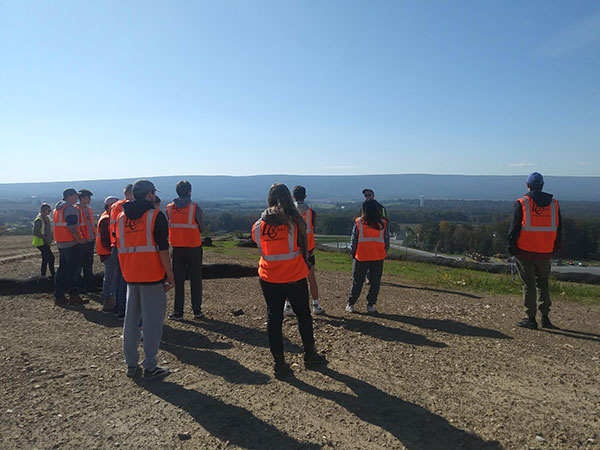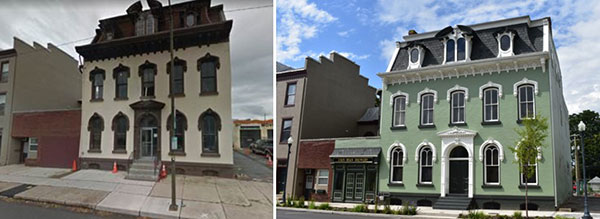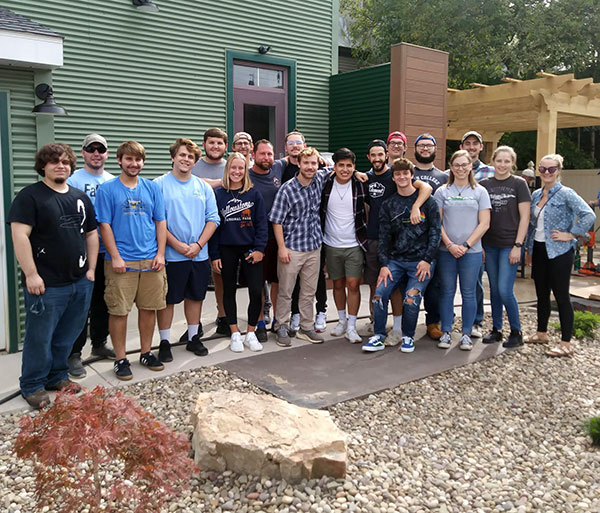Architecture curriculum enriched through site visits
Published 11.05.2021
News
Architecture & Sustainable Design
Student News
Faculty & Staff
Engineering Technologies
Layering a respect for history over their career-focused thirst for knowledge, students in two of Rob A. Wozniak’s architecture courses recently benefited from eye-opening visits to the Lycoming County Resource Management Services landfill in Allenwood and the soon-to-open John R. T. Ryan Restaurant & Brewery in a section of downtown Williamsport under extensive redevelopment.
 Lycoming County Resource Management Services
Lycoming County Resource Management Services
“What a beautiful day to see and learn about trash,” said Wozniak, an associate professor of architectural technology. “No seriously! Both days were beautiful” as he accompanied two sections of Sustainability: Living and Building Green (ACH262) students on tours of the 47-year-old landfill – the only county-owned operation of its kind in the commonwealth.
“The two separate classes appreciated the time spent explaining the processes for the recycling center, the landfill and the co-generation station,” he said. “The goal was to not only see such facilities firsthand, to see the process of how it operates behind the scenes, but also to be aware of our daily purchases as consumers, considering the choices we make, how the products are made, and will the item last … or be quickly discarded?”
Employees Lauren Strausser and Donald F. Hassenplug Jr. hosted the tours of the landfill, which occupies about 110 acres of a 500-acre parcel – federally owned property that represents part of the former town of Alvira, taken by eminent domain in World War II to create the Pennsylvania Ordnance Works for the production of TNT.
 According to comprehensive field-trip summaries prepared by Wozniak (and excerpted here), students gained perspective on the landfill itself – which generates revenue from the various "tipping fees" from the multiple trucks that dispose of some 1,200 daily tons of residual manufacturing waste and municipal trash – as well as learning about regular monitoring and other substantial improvements over the open garbage dumps that existed prior to the mid-1970s.
According to comprehensive field-trip summaries prepared by Wozniak (and excerpted here), students gained perspective on the landfill itself – which generates revenue from the various "tipping fees" from the multiple trucks that dispose of some 1,200 daily tons of residual manufacturing waste and municipal trash – as well as learning about regular monitoring and other substantial improvements over the open garbage dumps that existed prior to the mid-1970s.
They also toured the co-gen facility operated by Energy Power Partners, which captures methane gas and converts it to electricity via large generators. Half of that electricity provides up to 90% of the power needs of the neighboring Federal Correctional Complex and half is sent to the national grid; heat from the conversion process is piped underground to warm the various LCWMS buildings.
Wozniak related that the recycling center, while a valuable revenue-generator that helps keeps the overall operation fiscally solvent, is subject to unpredictable market fluctuations in the worth of the commodities collected (cardboard, plastic and glass, for instance).
 John R.T. Ryan Restaurant & Brewery
John R.T. Ryan Restaurant & Brewery
"John R.T. Ryan?" Wozniak asked. "We hear various other local names, like Peter Herdic, Edwin and Emma Rowley, James V. Brown, Agnes Hermance and others. But who was John R. T. Ryan?"
During another recent class site visit, Historic Preservation (BSD410) students learned the answer through an article that Matt DiRocco wrote as co-owner of the soon-to-be-opened John R. T. Ryan Restaurant & Brewery.
Ryan was one of the original Williamsport businessmen of the "Old City" region, which predated the development of Millionaires Row near what is now the Penn College campus. Old City is in the same part of the city that is gradually being redeveloped in the neighborhood of Lycoming College and includes the former 151 E. Third St. home of Ryan and his wife, the former Lina Tinsman (daughter of another successful Williamsport pioneer, Garrett Tinsman).
 Originally from Trenton, New Jersey, Ryan came to Williamsport in 1866, the year the city was incorporated. The class learned that he was involved with several business opportunities and obtained a U.S. patent for a passenger railway car brake and starter device. Along with that, he was either a principal investor, a director or president for four lumber enterprises and a variety of other businesses, including the Williamsport Hydraulic Brick Co., the Lycoming Wireless Umbrella Co., Biscuits & Confectionery, an electric company and a railway company, Eagles Mere and Grampian land companies, the Ryan business block (Market, Mulberry and Third streets), and the Ulman Opera House.
Originally from Trenton, New Jersey, Ryan came to Williamsport in 1866, the year the city was incorporated. The class learned that he was involved with several business opportunities and obtained a U.S. patent for a passenger railway car brake and starter device. Along with that, he was either a principal investor, a director or president for four lumber enterprises and a variety of other businesses, including the Williamsport Hydraulic Brick Co., the Lycoming Wireless Umbrella Co., Biscuits & Confectionery, an electric company and a railway company, Eagles Mere and Grampian land companies, the Ryan business block (Market, Mulberry and Third streets), and the Ulman Opera House.
“The opportunity for students to visit and learn about this anticipated business and the various work that is being wrapped up was perfect!” Wozniak said. “It demonstrates and emphasizes that the ‘greenest building is the one that already is built.’ In other words, all the embodied energy that went into the production, the shipping and the installation of all these building materials is more sustainable to keep them in place and reuse the building, rather than demolishing and potentially disposing of these – to manufacture, transport and build again, using new materials.”
Wozniak and the students thank DiRocco, John Roskowski and William Winfield for taking the time to tell their story of this adaptive reuse opportunity of which they took advantage. After several years of effort, the group was told, the John R. T. Ryan venue is slated to be open for business before the end of the year.
 Lycoming County Resource Management Services
Lycoming County Resource Management Services“What a beautiful day to see and learn about trash,” said Wozniak, an associate professor of architectural technology. “No seriously! Both days were beautiful” as he accompanied two sections of Sustainability: Living and Building Green (ACH262) students on tours of the 47-year-old landfill – the only county-owned operation of its kind in the commonwealth.
“The two separate classes appreciated the time spent explaining the processes for the recycling center, the landfill and the co-generation station,” he said. “The goal was to not only see such facilities firsthand, to see the process of how it operates behind the scenes, but also to be aware of our daily purchases as consumers, considering the choices we make, how the products are made, and will the item last … or be quickly discarded?”
Employees Lauren Strausser and Donald F. Hassenplug Jr. hosted the tours of the landfill, which occupies about 110 acres of a 500-acre parcel – federally owned property that represents part of the former town of Alvira, taken by eminent domain in World War II to create the Pennsylvania Ordnance Works for the production of TNT.
 According to comprehensive field-trip summaries prepared by Wozniak (and excerpted here), students gained perspective on the landfill itself – which generates revenue from the various "tipping fees" from the multiple trucks that dispose of some 1,200 daily tons of residual manufacturing waste and municipal trash – as well as learning about regular monitoring and other substantial improvements over the open garbage dumps that existed prior to the mid-1970s.
According to comprehensive field-trip summaries prepared by Wozniak (and excerpted here), students gained perspective on the landfill itself – which generates revenue from the various "tipping fees" from the multiple trucks that dispose of some 1,200 daily tons of residual manufacturing waste and municipal trash – as well as learning about regular monitoring and other substantial improvements over the open garbage dumps that existed prior to the mid-1970s.They also toured the co-gen facility operated by Energy Power Partners, which captures methane gas and converts it to electricity via large generators. Half of that electricity provides up to 90% of the power needs of the neighboring Federal Correctional Complex and half is sent to the national grid; heat from the conversion process is piped underground to warm the various LCWMS buildings.
Wozniak related that the recycling center, while a valuable revenue-generator that helps keeps the overall operation fiscally solvent, is subject to unpredictable market fluctuations in the worth of the commodities collected (cardboard, plastic and glass, for instance).
 John R.T. Ryan Restaurant & Brewery
John R.T. Ryan Restaurant & Brewery"John R.T. Ryan?" Wozniak asked. "We hear various other local names, like Peter Herdic, Edwin and Emma Rowley, James V. Brown, Agnes Hermance and others. But who was John R. T. Ryan?"
During another recent class site visit, Historic Preservation (BSD410) students learned the answer through an article that Matt DiRocco wrote as co-owner of the soon-to-be-opened John R. T. Ryan Restaurant & Brewery.
Ryan was one of the original Williamsport businessmen of the "Old City" region, which predated the development of Millionaires Row near what is now the Penn College campus. Old City is in the same part of the city that is gradually being redeveloped in the neighborhood of Lycoming College and includes the former 151 E. Third St. home of Ryan and his wife, the former Lina Tinsman (daughter of another successful Williamsport pioneer, Garrett Tinsman).
 Originally from Trenton, New Jersey, Ryan came to Williamsport in 1866, the year the city was incorporated. The class learned that he was involved with several business opportunities and obtained a U.S. patent for a passenger railway car brake and starter device. Along with that, he was either a principal investor, a director or president for four lumber enterprises and a variety of other businesses, including the Williamsport Hydraulic Brick Co., the Lycoming Wireless Umbrella Co., Biscuits & Confectionery, an electric company and a railway company, Eagles Mere and Grampian land companies, the Ryan business block (Market, Mulberry and Third streets), and the Ulman Opera House.
Originally from Trenton, New Jersey, Ryan came to Williamsport in 1866, the year the city was incorporated. The class learned that he was involved with several business opportunities and obtained a U.S. patent for a passenger railway car brake and starter device. Along with that, he was either a principal investor, a director or president for four lumber enterprises and a variety of other businesses, including the Williamsport Hydraulic Brick Co., the Lycoming Wireless Umbrella Co., Biscuits & Confectionery, an electric company and a railway company, Eagles Mere and Grampian land companies, the Ryan business block (Market, Mulberry and Third streets), and the Ulman Opera House.“The opportunity for students to visit and learn about this anticipated business and the various work that is being wrapped up was perfect!” Wozniak said. “It demonstrates and emphasizes that the ‘greenest building is the one that already is built.’ In other words, all the embodied energy that went into the production, the shipping and the installation of all these building materials is more sustainable to keep them in place and reuse the building, rather than demolishing and potentially disposing of these – to manufacture, transport and build again, using new materials.”
Wozniak and the students thank DiRocco, John Roskowski and William Winfield for taking the time to tell their story of this adaptive reuse opportunity of which they took advantage. After several years of effort, the group was told, the John R. T. Ryan venue is slated to be open for business before the end of the year.
Photos provided